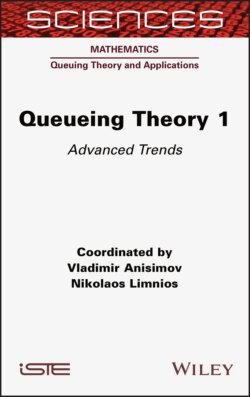Читать книгу Queueing Theory 1 - Nikolaos Limnios - Страница 21
1.3.2. The PH/PH/1 system
ОглавлениеConsider a PH/PH/1 system with interarrival times and service times that are represented by (α,T) and (β, B), respectively, with means given as a–1 and b–1 . Note that a–1 = α(I – T)–11 and b–1 = β(I – B)–11. At time t ≥ 0, let Xt be the number of items in the system,Yt the phase of interarrival times and Zt the phase of the ongoing service. It is straightforward to see that (Xt, Yt, Zt), t ≥ 0, is a DTMC with transition matrix P given as
where
and where ⊗ is the Kronecker product. For two matrices U of order n × m and V of order r × k, the product U ⊗ W is a matrix of order nr × mk (for more details, see Graham 1981).
It is well-known in the literature that for a stable PH/PH/1 system there is a matrix R, with spectral radius less than 1, which is the minimal non-negative solution to and the stationary distribution of the DTMC, which is given as can be obtained through the matrix-geometric theorem (Neuts 1981) as
after appropriately obtaining the boundary solution [x0, x1]. For more details, see Alfa (2016).
The idea of the Geo/Geo/1 system discussed in section 1.2 can be extended to the PH/PH/1, but requires a more involved representation and analysis. Consider the case where (α,T) depends on (β, B). The dependence can be captured by letting
with the condition that
We see that the case of the Geo/Geo/1 is a special case where (β, B) = (1, b), hence . several functional forms of α = gα(β), and T = fT(B) can be studied, but are beyond the scope of this chapter. However, a small example of a representation is presented as an illustration. Consider a simple case with T and B having the same size, i.e. n × n. Define a doubly stochastic matrix V of order n × n. We can select
provided
Even though this system is more complicated to analyze compared to the Geo/Geo/1 case, the idea is exactly the same and it can be studied numerically.
Next we consider a model in which there is a general service time distribution; however, there are several interarrival time distributions and the selection of the next interarrival time distribution depends on the service time distribution.
